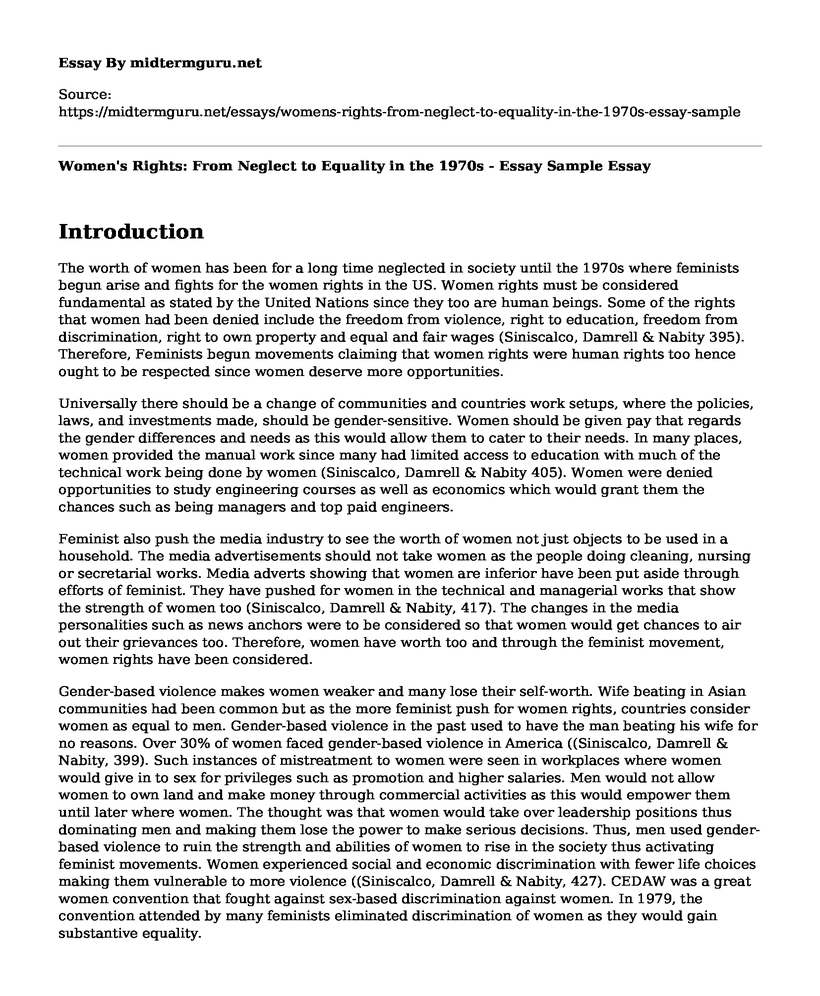Introduction
The worth of women has been for a long time neglected in society until the 1970s where feminists begun arise and fights for the women rights in the US. Women rights must be considered fundamental as stated by the United Nations since they too are human beings. Some of the rights that women had been denied include the freedom from violence, right to education, freedom from discrimination, right to own property and equal and fair wages (Siniscalco, Damrell & Nabity 395). Therefore, Feminists begun movements claiming that women rights were human rights too hence ought to be respected since women deserve more opportunities.
Universally there should be a change of communities and countries work setups, where the policies, laws, and investments made, should be gender-sensitive. Women should be given pay that regards the gender differences and needs as this would allow them to cater to their needs. In many places, women provided the manual work since many had limited access to education with much of the technical work being done by women (Siniscalco, Damrell & Nabity 405). Women were denied opportunities to study engineering courses as well as economics which would grant them the chances such as being managers and top paid engineers.
Feminist also push the media industry to see the worth of women not just objects to be used in a household. The media advertisements should not take women as the people doing cleaning, nursing or secretarial works. Media adverts showing that women are inferior have been put aside through efforts of feminist. They have pushed for women in the technical and managerial works that show the strength of women too (Siniscalco, Damrell & Nabity, 417). The changes in the media personalities such as news anchors were to be considered so that women would get chances to air out their grievances too. Therefore, women have worth too and through the feminist movement, women rights have been considered.
Gender-based violence makes women weaker and many lose their self-worth. Wife beating in Asian communities had been common but as the more feminist push for women rights, countries consider women as equal to men. Gender-based violence in the past used to have the man beating his wife for no reasons. Over 30% of women faced gender-based violence in America ((Siniscalco, Damrell & Nabity, 399). Such instances of mistreatment to women were seen in workplaces where women would give in to sex for privileges such as promotion and higher salaries. Men would not allow women to own land and make money through commercial activities as this would empower them until later where women. The thought was that women would take over leadership positions thus dominating men and making them lose the power to make serious decisions. Thus, men used gender-based violence to ruin the strength and abilities of women to rise in the society thus activating feminist movements. Women experienced social and economic discrimination with fewer life choices making them vulnerable to more violence ((Siniscalco, Damrell & Nabity, 427). CEDAW was a great women convention that fought against sex-based discrimination against women. In 1979, the convention attended by many feminists eliminated discrimination of women as they would gain substantive equality.
Conclusion
In summary, feminists aimed at formulating customs which would protect women working in both the private and public sector. Through the feminist movement, women gained more participation in the public sphere, were recognized as citizens with the right to vote and could move across the country without interruption. The women bill of rights treated both men and women equally. However, it made more foundation on the political and civil rights where positive measures had to be put into place immediately to deliver women who were being mistreated. Employment opportunities increased through the movement and women efforts in leading to growth and development of the economy were recognized.
Work Cited
Siniscalco, Gary, Lauri Damrell, and Clara Morain Nabity. "The Pay Gap, The Glass Ceiling, and Pay Bias: Moving Forward Fifty Years After the Equal Pay Act." ABAJ Lab. & Emp. L. 29 (2013): 395.
Cite this page
Women's Rights: From Neglect to Equality in the 1970s - Essay Sample. (2023, Feb 09). Retrieved from https://midtermguru.com/essays/womens-rights-from-neglect-to-equality-in-the-1970s-essay-sample
If you are the original author of this essay and no longer wish to have it published on the midtermguru.com website, please click below to request its removal:
- Research Essay Sample: Effects of Chronic Homelessness in Our Society
- Essay on Substance Abuse Prevalence and Patterns
- Paper Example on Immigration of the Mexicans to the United States
- Research Paper on Young Blacks and Criminal Justice
- The Literature of Protest: The Yellow Wallpaper by Charlotte Perkins Gilman
- Addiction: A Disease or Not? - Essay Sample
- Critical Essay on Clothes by Chitra Banerjee Divakaruni







